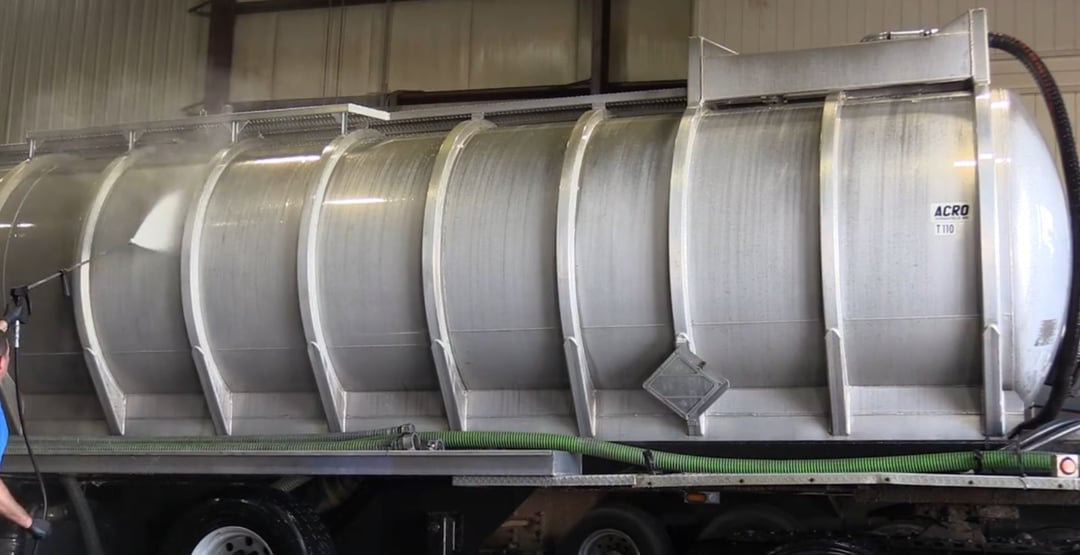If you manage a truck fleet, then you know how tedious it can be to have them all washed efficiently and effectively. But have you ever wondered why your fleet still has streaks and water spots after you wash it?
It actually happens a lot more often than you think.
There are quite a few reasons why this happens — water pressure, dilution, and even the type of soap you use. But the biggest reason why vehicles don’t look clean after you wash them is water quality.
Poor water quality, whether it’s diluted with soap or just used for rinsing at the end, can leave a blotchy appearance on the surface and undercarriage.
This isn’t just an aesthetic issue that hurts your brand reputation. If left unchecked, this can lower the life expectancy of your vehicles.
That’s why we compiled six tips that will help you reduce streaks, blotches, and inconsistent truck washes.
1. 2-step wash
A normal 1-step wash only gets half the job done. That’s because a single wash may be enough to get rid of most of the dirt, but it won’t completely remove road film, oxidation, or mineral deposits.
Road film is the shadowy overlay on the truck’s surface that you might still notice after washing. It may look clean, but running a finger over the paint shows road film remaining.
Road film is made up of dirt, diesel smoke & other contaminants mixing together. The reason it is so hard to remove is that it forms an electrostatic bond to your trucks — similar to a magnet.
The best way to get rid of it is to use a 2-Step washing processing. Typically, you would apply a low pH presoak first. This will neutralize the negatively charged road film while the second-step, high-pH detergent eliminates the remaining positively charged road film particles.
2. Cleaning Direction
The physical way in which you put the cleaning products on the surface of the vehicle is another key component to an efficient clean.
It may seem like common sense to lather your vehicle from the top to the bottom but you actually want to start with the wheels — and you want to do it in overlapping motions.
This is a much more efficient process and helps mitigate streaking, especially on larger vehicles such as semi-trucks and trailers.
It’s important to note this all changes when it comes to rinsing off the soap. This is when you want to start from the top and work your way to the bottom.
3. Water pressure and water temperature
This should come as no surprise, but using water at very high pressure can damage your vehicles. It can ruin the finish and scratch any decal or branding.
A low-pressure wash won’t be much help either. While it will wash away some soil and dirt, this is what often leaves a blotchy, uneven appearance. You want about 1800 to 2200 PSI for optimal fleet washing.
When it comes to water temperature, you often want a warmer wash. On average, aim for about 110 degrees, though it may be less in the warmer months or you may want to use cold water on hot vehicles that have just come off the road.
The warm water makes it easier to remove road film, reduces the amount of soap you need, and gives you more consistency.
If you’re in the Midwest, you could increase the temperature during the colder months but don’t exceed 130 degrees. If the water is too hot, you will damage the surface of your vehicles.
4. Hands-on vs touchless wash
Washing a single vehicle is much easier than a whole fleet. That may be when a hands-on wash makes sense.
But it’s extremely inefficient and it would take days to wash and wipe down an entire convoy.
If you are using a brush, there’s a chance you're also damaging the paint on the surface of your vehicles with micro scratches.
A touchless wash system helps you clean your fleet in a fraction of the time, without compensating for quality. A touchless wash can also be done by a single person in the time it would take multiple people to manually scrub a vehicle. This saves not only time but also labor costs.
5. Thorough undercarriage wash
One of the most overlooked parts of cleaning your truck is the bottom and undercarriage. Without cleaning the undercarriage, it can look as though you've only done half the wash. This is also where the majority of rust happens — and if left unnoticed, will cause serious damage in time.
This happens when dirt and grime clog up the small drainage holes and deteriorates the metal. But this can be easily avoided with a thorough undercarriage wash.
If you’re in the Midwest — or anywhere with a lot of snow — it’s also important to clean off any build-up of corrosive salts and calcium de-icers.
6. Quality chemicals
Getting a better clean sometimes comes down to the products you use.
High-quality, biodegradable detergents that include a powerful surfactant package will allow you to clean more vehicles in less time.
The key is to make sure you have the correct dilution, so remember to check the label or the manufacturer for the optimal ratio.
Conclusion
If you often find streaks, oxidized paint, and spotting after you wash a fleet, you’re not alone. This actually happens to a lot of truck owners and can happen for a number of reasons.
But these six cleaning tips will not only improve your fleet washing routine and reduce watermarks but help you save time and money while doing it.
For a better washing experience, give Hydro-Chem Systems a call. Our consultants offer personalized cleaning solutions and have helped hundreds of companies clean their fleets at the lowest cost-per-wash for more than 50 years.


